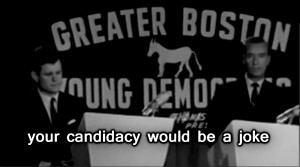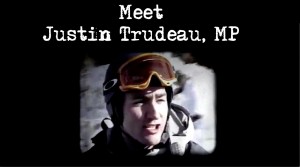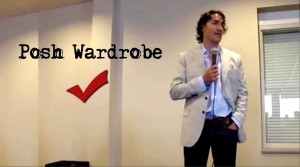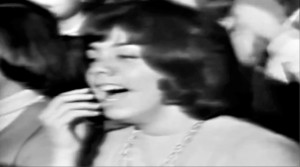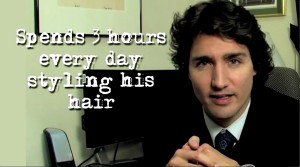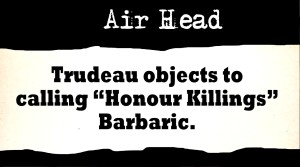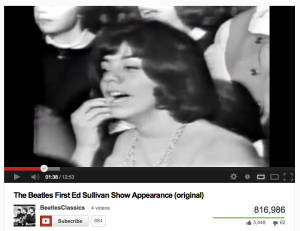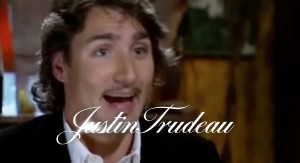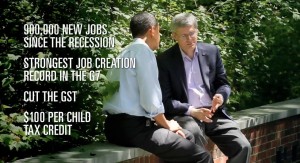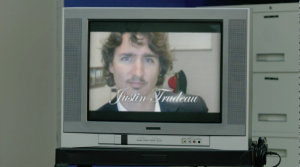Trudeau Attack Ad Codes and Conventions
Justin Trudeau’s early days in Parliament as the new Leader of the Liberal Party were accompanied by Conservative Party attack ads. Attack ads criticize personal attributes of their targets rather than the policies they might promote. All political parties use attack ads, but the Conservative ads have been harsh and effective. Mr. Trudeau is the 4th Liberal leader in a short time, each of whom were the objects of strong attack ads. Mr. Trudeau follows Stephane Dion, Michael Ignatieff and interim leader Bob Rae, who took over after Mr. Ignatieff lost his seat—and Official Opposition status—in the 2012 election.
Attack ads are intended to be nasty to the point of exaggeration, but if they contain grains of truth, they can create doubts that might persuade audiences. Mr. Dion is brilliant, but was a weak leader. Mr. Ignatieff could not overcome the possibility that he opportunitiscally had come back to Canada from the US for the to become PM.
Attack ads are curious because they are personal and because there is a risk of blow-back on their creators, meaning that audiences might respond with anger at the creators for using personal attacks rather than with anger at the targets. So far, the risk has been worth it for the Conservatives.
You will have the opportunity to decide if the Trudeau attack ads are successful through an exploration of the codes and conventions they utilize to encourage negative feelings for Mr. Trudeau. You will also explore the Liberal Party’s response ad.
The ads (two will be discussed here) use a variety of carefully-constructed media messages and forms to encourage the audience to dislike Mr. Trudeau.
The first ad is Where would he be without his last name? It begins with an historical allusion to a 1962 election in Boston. You can see it here.
Viewers see 2 men on a political rally stage: Teddy Kennedy and a man named McCormack. Mr. McCormack suggests that if Teddy did not have Kennedy as a last name, “your candidacy would be a joke.” Mr. McCormack’s statements are communicated both orally and in subtitles.
Why might the ad’s creators have added subtitles?
The video then brings viewers to the present and to the statement, “Meet Justin Trudeau, MP.” Mr. Trudeau’s first appearance shows him wearing ski equipment. A male voice-over gushes, “I love Justin Trudeau! He’s just…. he’s dreamy!”
A male voice lists Mr. Trudeau’s ‘qualifications,’ including ‘Trust fund narcissist,’ ‘Posh wardrobe,’ ‘Always keeping shirt unbuttoned for the ladies.’
These qualities are accompanied by the sounds of screaming women and a male voice chanting, ‘I’m too sexy for my land.’
Then we see screaming women in black and white.
The ad continues:
And with “Air Head,” accompanied by Mr. Trudeau’s voice explaining, “‘Barbaric‘ has more of an opportunity to set someone’s hackles up.”
The ‘I’m too sexy for your party’ chant continues, while the ad finishes with a white-out line drawn through the word, ‘Trudeau,’ leaving just ‘Justin’ and ‘Where would he be without his last name?’
Discussion:
The historical allusion to the Kennedy event might suggest that neither Teddy Kennedy nor Justin Trudeau would be politically successful without their last names. But does the allusion work in the minds of viewers? 1962 was 51 years before Mr. Trudeau’s ascension to Leader. During that time, Senator Edward Kennedy became a successful Senator and popular statesman, dying in 2009.
Which Edward Kennedy will 2013 viewers remember, the 1962 upstart or the 2009 statesman?
Which feelings might they transfer onto Mr. Trudeau, upstart or statesman?
The characteristics referenced are Mr. Trudeau’s wealth, his unbuttoned shirt, his curly hair and his ‘air-head’ statement about honour killings.
What impression do they give of Mr. Trudeau?
How likely will viewers connect these characteristics with an inability to lead the Liberal Party or Canada?
There is a strong use of visual contrasts. Black and white or colour contrasts are used in several images. The title font is Courier, the font used by manual typewriters invented in the late 19th century. The letters appear irregular, smudged.
How might these contrasting colours and primitive type faces influence viewers’ feelings towards Mr. Trudeau?
The black and white images of screaming women have been edited in from a 1964 Beatles’ Ed Sullivan Show appearance (see Youtube screen below).
Why might the creator have taken video of screaming women from half-a-century ago?
How viewers think differently if they recognized the video’s source?
When Mr. Trudeau speaks about honour killings being called ‘barbaric’ (“‘Barbaric‘ has more of an opportunity to set someone’s hackles up,”) might he be talking about honour killings, or about the choice of the word ‘barbaric’ and its effect on cultures who condone honour killings?
How might the chant, “I’m too sexy for my clothes/land/party” influence viewers?
How effectively do the sound, images words and editing combine to create a negative feeling towards Mr. Trudeau?
Which characteristics might viewers be sufficiently concerned about to allow the ad to influence their opinions?
How many viewers might consciously notice the song, the contrasts, the primitive font and the visual dissonance of the editing?
How effectively do you think this attack ad uses codes and conventions of image, sound, music and type to create a negative feeling?
How likely do you think the audience is to agree with its message as compared to think the ad is a failed character assassination?
He’s in way over his head
The second attack ad, He’s in way over his head, also uses codes and conventions of attack ads effectively. See it here.
Look at the fonts and consider why the creators chose a script font for Mr. Trudeau’s name and a sans serif font for the rest of the ad.
Mr. Trudeau has a faint moustache in these images, while he is clean shaven as Liberal Leader. Why might the creator have chosen an image that represents him with a moustache? How might a faint moustache support the ad’s message that he is ‘in over his head?’
We then see several shots of Mr. Harper, one in a hard hat at a factory, one walking with his wife and one having a one-on-one chat with Barack Obama. Titles roll that describe Mr. Harper’s accomplishments. There is classical piano music on the soundtrack.
The next shot places Mr. Trudeau on the left and Mr. Harper on the right with titles and voice-over describing Mr. Trudeau’s accomplishments.
Then we see Mr. Trudeau disrobing in a purple light.
The music accompanying the stripping sounds like merry-go-round music.
How do these sounds and images contrast?
How might they influence the audience’s feelings towards each man?
Finally, Mr. Trudeau’s name reappears in sparkles while the voice-over states, “Justin Trudeau, he’s in way over his head.”
The final screen includes a website: justinoverhishead.ca and the Conservative Party logo.
Discussion:
The script font, the faint moustache, the merry-go-round music and the stripping might all be designed to attack Mr. Trudeau’s masculinity and throw doubt on his ability to run a government.
Do they have that effect on you? Would they have that effect on most of the people you know?
Mr. Trudeau DID do a striptease to raise $1900 in support of finding a cure for liver cancer.
How might that information change an audience’s feelings about him doing a strip tease?
Mr. Trudeau DID teach drama, math and French.
How might teaching develop skills that could help someone lead a political party?
Who else taught, then went into politics? (David Crombie & Lyndon Johnson)
How might that additional information change an audience’s feelings about the drama teacher comment?
Mr. Trudeau is the leader of the third party in Parliament, NOT the Leader of the Opposition. That role is being filled by Thomas Mulcair, Leader of the NDP Party of Canada.
Why might the Conservatives feel it is necessary to attack Mr. Trudeau personally BEFORE he begins to represent his party?
justinoverhishead.ca takes the user to a website that presents a list of reasons why Mr. Trudeau is not capable of leading Canada. It also solicits donations “so more Canadians can watch our ads.” Doing a whois search does NOT reveal the owner of the site, nor is an owner indicated on the site.
Why might the creators not want to disclose who owns the site?
Why would they omit their identity when the Conservative Party logo is clearly displayed at the end of the attack ad?
Footnotes:
1. The Conservative Party created a range of pamphlets for home delivery to reinforce the messaging in the attack ads. Their internal order form was leaked, so now the public can see the ‘man behind the curtain’ who is running the attack as well as the taxpayer-funded fees for the printing and delivering of the pamphlets. You can see the order form here.
And blow-back began. The Canadian Teachers’ Federation president expressed outrage that the attack ads demeaned the teaching profession as well as Mr. Trudeau. Conservative spokespersons back peddled, explaining, “Being a drama teacher for two years doesn’t provide you with the experience to run a G-7 economy in a period of global economic uncertainty. Pointing this out isn’t an attack on the teaching profession or people who’ve built a solid record of success by sticking with the teaching profession for more than two years.” Does the spokesperson’s claim that it was the two-year duration rather than the teaching profession that was intended to demonstrate Mr. Trudeau’s lack of abilities convince you that Mr. Trudeau lacks qualifications to lead Canada?
The Toronto Star reported that Conservative MPs were refusing to send the pamphlet to their constituents. Mr. Trudeau claimed some had privately told him that they find the ads embarrassing, but did not say who.
Why might Mr. Trudeau hide the identities of the dissenting Conservative MPs?
Does it affect his credibility for him to claim that some Conservative MPs have spoken to him privately but refuse to identify them?
2. Steve Paikin interviewed David Herle (a political marketing executive) on The Agenda about the effectiveness of attack ads, particularly the He’s in way over his head ad.
After considering the context of the ads as well as the codes and conventions used to build them, how effective do you think they will be in influencing Canadians’ feelings towards Mr. Trudeau?
Attack Ads Part 2
There was considerable debate among political pundits as to whether the Liberal Party should ignore or rebut the attack ads. Some stated that it was better to take the moral high ground and ignore the attacks. Others insisted that this strategy would be a mistake because ignoring the attack ads would allow the Conservative party to set the agenda while responding would allow the Liberal Party to regain the agenda.
A few days went by while pundits debated, then the Liberal Party released a response ad entitled Channel Change. You can see it here.
The ad begins by referencing the Conservative attack ad, placing it inside a TV frame.
Then it cuts to Mr. Trudeau, who turns the ad off while sitting on a teacher’s desk in a classroom.
There are math problems on a chalkboard and a globe on a bookcase.
There are rays of bright light on the chalkboard behind him.
He begins, “Canadians deserve better. ” Then he offers a choice between ‘mistrust and finding flaws in each other’ or ‘pulling together.’
He states that he worked hard to be an MP and Liberal leader, is proud to be a teacher, son and father.
He invites Canadians to work together to build a better Canada.
Discussion:
The TV is a CRT model rather than the current flat-screen. There is no evidence of computer technology. The globe is set to display North America. There is a Canadian flag on the desk.
Which audience might this classroom have been designed to appeal to, people currently at school or people who have graduated and have jobs and children?
What is the effect of placing the ad inside a classroom TV?
How does that placement re-contextualize the ad?
How does placing Mr. Trudeau in a classroom influence how viewers might feel about him?
Is he teaching viewers about attack ads?
What might be the effect on viewers of the rays of light behind Mr Trudeau’s head?
This ad contains four shots in 30 seconds, whereas the Conservative ads contain 13 and 8 shots respectively, plus rapid superimposed titles .
How might the editing pace of the three ads influence viewers’ feelings towards Mr. Trudeau?
Mr. Trudeau attacks, but he attacks the ads and not the Conservative Party or Mr. Harper.
Was this a good strategy or is it consistent with the messages communicated by the Conservative attack ads?
Did you notice the older TV set? The rays of light? The globe? The math on the chalkboard? The lack of computer technology in a classroom?
Do you think people you know would notice and think about those parts of the ad’s message?
There is a French language version of the response. It begins with Mr. Trudeau sitting on the teacher’s desk but without a reference to the attack ad. While Mr. Trudeau says many of the same ideas en français, there is a rapid succession of images of him attending a variety of political meetings. The last shot returns to Mr. Trudeau on the teacher’s desk.
Why might the French version of the ad ignore the Conservative attack ads?
Why might it include many shots of Mr. Trudeau in other locations rather than staying with him on the teacher’s desk?
How might the French ad have a different effect on its audience than the English ad?
Researcher Allan Gregg explained that Canadian political parties do not need to appeal to large portions of the electorate. You can see the speech here.
When only 40% of the electorate vote, parties only need to motivate 21% to vote them a majority. That means that the Conservative attack ads can alienate at least 75% of Canadians but if they re-affirm the ideological thinking of the Conservative base, and those people are not bothered by attack ads, they have done their jobs.
The Liberals, on the other hand, need to expand their proportion of supporters to move from third to second place. They not only need to produce ads that re-affirm the ideological thinking of the Liberal base, but must convert non-Liberal supporters.
Does the Liberal response ad re-affirm the ideological thinking of the Liberal base AND convert non-Liberal supporters?
Can you suggest a design for an ad that might do that more effectively?
How has this blog changed the way that you think about attack ads?
How has this blog changed how you feel about the importance of media literacy to voters?


